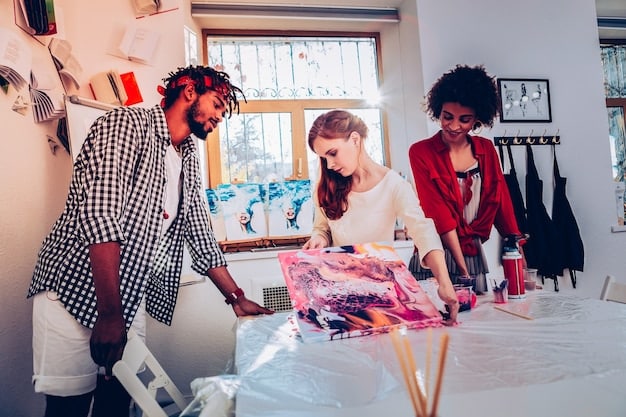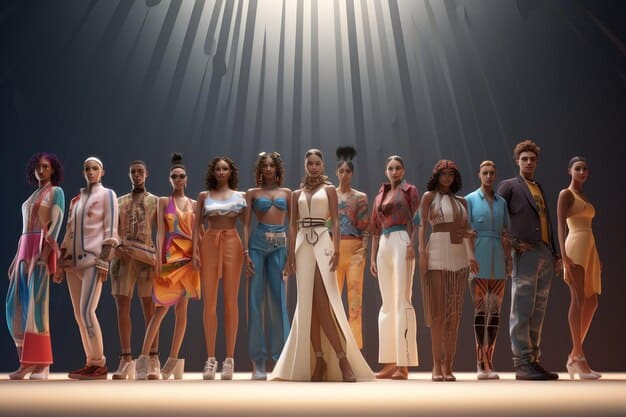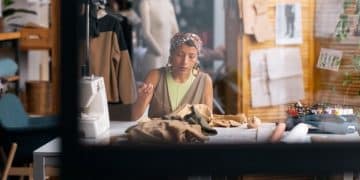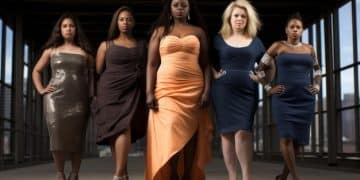Key Trends Shaping the Future of US Fashion Design (Next 5 Years)

The key trends shaping the future of US fashion design in the next 5 years include sustainable practices, technology integration, inclusive design, the rise of personalized fashion, and a focus on local and ethical production.
The US fashion industry is on the cusp of significant transformation. From technological advancements to shifting consumer values, numerous forces are converging to redefine what we wear, how it’s made, and who gets to participate. Let’s dive into what are the key trends shaping the future of US fashion design in the next 5 years?
Sustainability and Ethical Practices
Consumers in the US are increasingly aware of the environmental and social impact of their clothing choices. This awareness is driving a demand for greater transparency and sustainability within the fashion industry.
Designers are responding by exploring innovative materials, rethinking production methods, and embracing circular economy models.
Innovative Materials
Traditional textiles like cotton and polyester have significant environmental footprints. Designers are seeking alternatives that are less resource-intensive and more eco-friendly.
Circular Fashion
The concept of circular fashion aims to minimize waste and extend the lifespan of clothing.
- Recycling and Upcycling: Transforming discarded materials into new garments.
- Rental and Resale Markets: Extending the use of existing clothing.
- Durable and Repairable Designs: Creating garments that last longer.

In conclusion, sustainability is no longer a niche trend, but a core value driving the future of US fashion design, emphasizing conscious design decisions.
Technology Integration
Technology is rapidly transforming the fashion industry, from design and production to retail and marketing.
Designers are using digital tools to create innovative products and personalize the customer experience.
3D Printing and Virtual Design
3D printing allows designers to create intricate prototypes and customized garments with minimal waste. Virtual design tools enable them to visualize and experiment with designs before physical samples are produced.
Artificial Intelligence (AI) and Machine Learning (ML)
AI and ML are being used to analyze consumer data, predict trends, and optimize supply chains.
- Personalized Recommendations: AI algorithms can analyze customer preferences and suggest clothing items that match their style.
- Automated Design: AI can generate design ideas based on market trends and consumer feedback.
- Efficient Inventory Management: ML can predict demand and optimize inventory levels, reducing waste and improving profitability.
Technology is revolutionizing the future of US fashion design, enabling greater creativity, efficiency, and personalization.
Inclusive Design and Body Positivity
The fashion industry is increasingly recognizing the importance of inclusivity and body positivity.
Designers are creating clothing that caters to a wider range of body types, abilities, and cultural backgrounds.

Adaptive Clothing
Adaptive clothing is designed to meet the needs of individuals with disabilities. These garments often feature modifications such as magnetic closures, easy-access openings, and adjustable fits. Adaptive clothing promotes independence and inclusivity.
Expanding Size Ranges
Brands are expanding their size ranges to include plus-size and petite options, reflecting the diversity of the US population. This shift promotes body positivity and makes fashion accessible to more people.
Inclusive design is reshaping the US fashion industry, promoting diversity, accessibility, and body positivity.
The Rise of Personalized Fashion
Consumers are increasingly seeking personalized experiences, and fashion is no exception. Designers are responding by offering customized clothing, bespoke services, and unique designs.
Personalized fashion allows individuals to express their unique style and preferences.
Customization and Bespoke Services
Many brands offer customization options, allowing customers to choose fabrics, colors, and details to create their own unique garments. Bespoke services provide a more personalized experience, with designers creating custom-made clothing tailored to the individual customer’s measurements and preferences.
Made-to-Order and On-Demand Production
Made-to-order and on-demand production models reduce waste by only producing garments that have already been purchased. This approach also allows for greater customization and personalization.
In conclusion, personalized fashion is empowering consumers to express their individuality and fostering a more sustainable and inclusive industry.
Local and Ethical Production
Consumers are increasingly interested in the origins of their clothing and the conditions under which it was produced.
This growing awareness is driving a demand for local and ethical production practices.
Supporting Local Designers and Artisans
Consumers are seeking out local designers and artisans who create unique, handcrafted clothing. Supporting local production helps to preserve traditional skills, create jobs, and reduce carbon emissions from transportation.
Fair Labor Practices
Ethical production ensures that garment workers are paid fair wages, work in safe conditions, and have the right to organize. Brands are increasingly transparent about their supply chains and committed to upholding fair labor practices.
Local and ethical production are gaining momentum in the US fashion industry, reflecting a growing desire for transparency, sustainability, and social responsibility.
The Impact of Social Media and Influencer Culture
Social media and influencer culture have a significant impact on fashion trends and consumer behavior.
Designers are leveraging social media platforms to connect with customers, showcase their designs, and build brand awareness.
Digital Marketing and E-commerce
Digital marketing and e-commerce are essential tools for fashion brands to reach a wider audience. Social media advertising, influencer collaborations, and online marketplaces provide opportunities to promote products and drive sales.
Influencer Collaborations
Collaborating with influencers can help brands reach new customers and build credibility. Influencers often have a loyal following and can effectively promote products and trends.
Social media and influencer culture continue to shape the US fashion landscape, influencing trends, consumer behavior, and brand strategies.
| Key Trend | Brief Description |
|---|---|
| 🌿 Sustainable Practices | Eco-friendly materials and circular fashion models. |
| 🤖 Technology Integration | AI, 3D printing, and virtual design. |
| 🫂 Inclusive Design | Adaptive clothing and expanded size ranges. |
| 🛍️ Personalized Fashion | Customization and made-to-order production. |
FAQ
▼
Rising sustainable materials include recycled polyester, organic cotton, hemp, Tencel, and innovative options like pineapple leather (Piñatex) and mushroom leather (Mylo). These reduce environmental impact and waste.
▼
AI is revolutionizing fashion design by predicting trends, personalizing recommendations, and automating design processes. It enhances creativity and makes the industry more efficient.
▼
Adaptive clothing is designed for individuals with disabilities, featuring modifications like magnetic closures and easy-access openings. It promotes independence and inclusivity in fashion.
▼
Personalized fashion caters to individual tastes, allowing customers to express their unique style through customized clothing and bespoke services. This trend boosts creativity and customer satisfaction.
▼
Local production supports local designers and artisans, preserves traditional skills, creates jobs, and minimizes transportation emissions. It also enhances transparency and ethical labor practices.
Conclusion
The US fashion industry is evolving rapidly, with key trends like sustainability, technology integration, personalized fashion, inclusive design, and local production. These movements reflect changing consumer values and promise a more innovative, ethical, and inclusive future for fashion.





